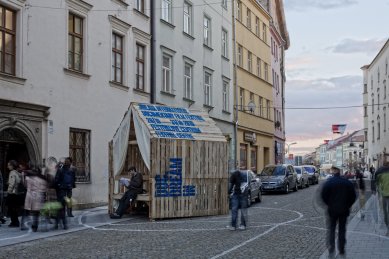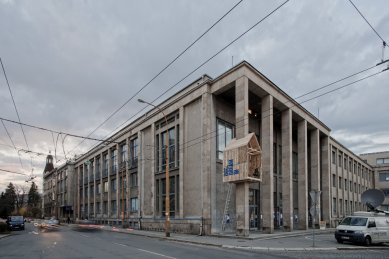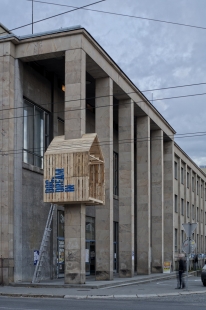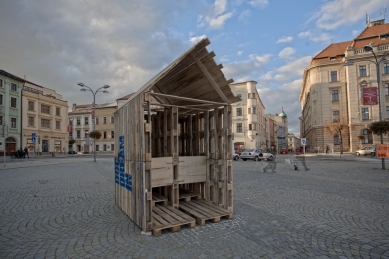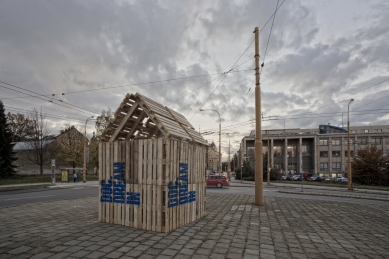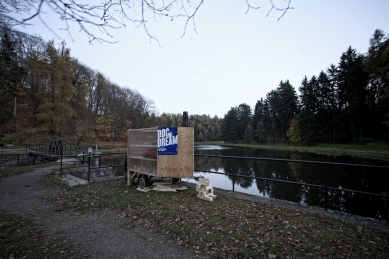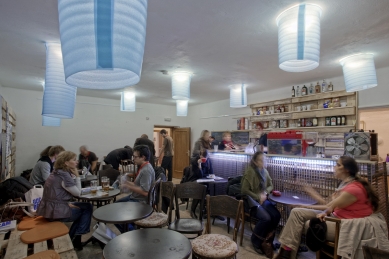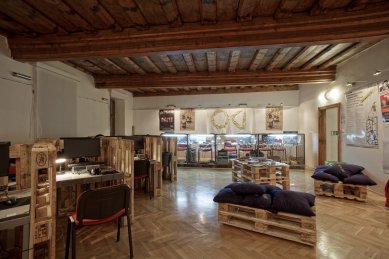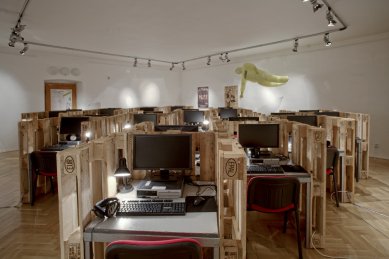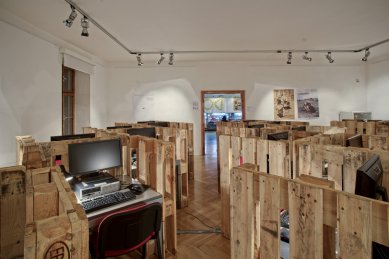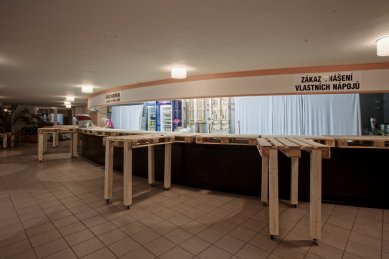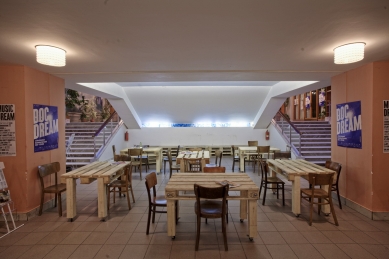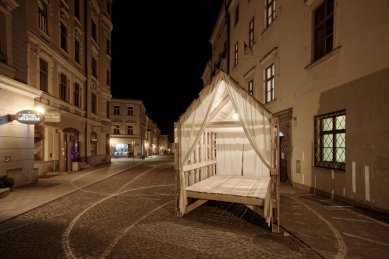
Architecture of the 14th MFDF Jihlava

After last year, we faced the challenge for the second time this year of providing the largest and most prestigious documentary film festival in Central and Eastern Europe with an architectural framework. Just like last year, the scope of the festival's adjusted spaces and the demands for them were great but the budget was small. Moreover, just like last year, we did not want to limit ourselves to merely meeting the utilitarian needs of the festival. The festival's outreach into public space was of equal importance to us. Once again, we intended to confront the festival audience and the residents of Jihlava with the surprise and cognitive awakening provoked by the suddenly appearing temporary architecture in the city.
The contradiction between a low budget and relatively demanding requirements for the festival architecture, along with the need to give the architectural form of the festival a certain "monumentality" (to make it worthwhile to address) requires a specific approach to problem-solving. It is necessary to find a basic construction principle based on elements that do not need to be purchased but can be borrowed from companies willing to support the festival in this way. This year, the classic wooden euro-pallet became such a construction element, along with raw steel grating in the interiors. Of course, using euro-pallets for building temporary architecture is not revolutionary or new. After all, I consider the effort to come up with something entirely new in architecture as foolish or impossible.
We were pleased that the festival center, with all its operations ensuring the processing of festival audiences and service to guests – professionals, has moved into new spaces of the Regional Gallery of Vysočina, unlike in the past. Thus, we did not have to confront ourselves with our own solution from last year. However, we faced a new problem: how to introduce temporary architecture into a valuable Renaissance building. We attempted this specifically using raw wood and steel so that the resulting "design" could not compete with the nobility of the space of the house. From the pallets, we created "platforms" of "grating-steel" counters for festival staff, various types of seating, and work structures for film professionals in East Silver (film market) or journalists in the Press Center. Both festival cafés are brutally pallet-based as well. The more intimate one in the gallery building and the one in DKO (House of Culture of Trade Unions with two festival cinemas that the festival has been using since 2004) features a monumental 16-meter long bar.
Every year, the festival has a specific motto. This year's is "Doc.Dream" – documentary dreaming. The connection of dream and documentary (reality) became our inspiration for a parallel conceptual architectural layer. We decided to enter the public space of the city with several "dreamlike" structures made of pallets and raw timber. These small "Doc.Dream In" structures are a significantly abstracted interpretation of their archetypes. They do not seek to resemble the archetypes in form; rather, they aim to allow the observer/user to have their own interpretations and individual dreams within the framework of associative play. In practical terms, all these structures serve as eye-catchers that significantly highlight the presence of the festival in the city. Thus, it is possible to use the shelter of the "tea pavilion" with a raised wooden floor in front of the festival center. Fair-trade tea, coffee, or vegetarian food can be purchased at the adjacent kiosk. Right on the main Masaryk square in Jihlava with the famous-infamous department store Prior, one can sit in the "viewing double-latrine". In the middle of the intersection at Freedom Square in front of DKO, cars circle around the "barn". Directly on the corner pillar of the monumental portico of DKO, there is a "perch". The only exception to the pallet uniformity is the last structure – the "public dream mobile sauna" located by the Stará plovárna pond. This was, of course, built in advance and arrived in Jihlava on its own wheels. It is available for festival guests overwhelmed by watching projections as well as for Jihlava citizens or simply anyone interested in mental and physical cleansing.
It should be noted that this year's construction of festival architecture was particularly demanding. Our hands handled all 450 used pallets during unloading, constant manipulation, and the construction itself. However, the construction of the perch was a structural delicacy but also an exhausting and fear-inducing performance. It is sad that as soon as we recover from the construction, we will have to demolish everything. Such is the fate of festival architecture...
However, there is still a chance to catch the festival until Saturday evening (October 30, 2010). Dismantling will begin on Sunday.
Yours, ECHTarchitektura
The contradiction between a low budget and relatively demanding requirements for the festival architecture, along with the need to give the architectural form of the festival a certain "monumentality" (to make it worthwhile to address) requires a specific approach to problem-solving. It is necessary to find a basic construction principle based on elements that do not need to be purchased but can be borrowed from companies willing to support the festival in this way. This year, the classic wooden euro-pallet became such a construction element, along with raw steel grating in the interiors. Of course, using euro-pallets for building temporary architecture is not revolutionary or new. After all, I consider the effort to come up with something entirely new in architecture as foolish or impossible.
We were pleased that the festival center, with all its operations ensuring the processing of festival audiences and service to guests – professionals, has moved into new spaces of the Regional Gallery of Vysočina, unlike in the past. Thus, we did not have to confront ourselves with our own solution from last year. However, we faced a new problem: how to introduce temporary architecture into a valuable Renaissance building. We attempted this specifically using raw wood and steel so that the resulting "design" could not compete with the nobility of the space of the house. From the pallets, we created "platforms" of "grating-steel" counters for festival staff, various types of seating, and work structures for film professionals in East Silver (film market) or journalists in the Press Center. Both festival cafés are brutally pallet-based as well. The more intimate one in the gallery building and the one in DKO (House of Culture of Trade Unions with two festival cinemas that the festival has been using since 2004) features a monumental 16-meter long bar.
Every year, the festival has a specific motto. This year's is "Doc.Dream" – documentary dreaming. The connection of dream and documentary (reality) became our inspiration for a parallel conceptual architectural layer. We decided to enter the public space of the city with several "dreamlike" structures made of pallets and raw timber. These small "Doc.Dream In" structures are a significantly abstracted interpretation of their archetypes. They do not seek to resemble the archetypes in form; rather, they aim to allow the observer/user to have their own interpretations and individual dreams within the framework of associative play. In practical terms, all these structures serve as eye-catchers that significantly highlight the presence of the festival in the city. Thus, it is possible to use the shelter of the "tea pavilion" with a raised wooden floor in front of the festival center. Fair-trade tea, coffee, or vegetarian food can be purchased at the adjacent kiosk. Right on the main Masaryk square in Jihlava with the famous-infamous department store Prior, one can sit in the "viewing double-latrine". In the middle of the intersection at Freedom Square in front of DKO, cars circle around the "barn". Directly on the corner pillar of the monumental portico of DKO, there is a "perch". The only exception to the pallet uniformity is the last structure – the "public dream mobile sauna" located by the Stará plovárna pond. This was, of course, built in advance and arrived in Jihlava on its own wheels. It is available for festival guests overwhelmed by watching projections as well as for Jihlava citizens or simply anyone interested in mental and physical cleansing.
It should be noted that this year's construction of festival architecture was particularly demanding. Our hands handled all 450 used pallets during unloading, constant manipulation, and the construction itself. However, the construction of the perch was a structural delicacy but also an exhausting and fear-inducing performance. It is sad that as soon as we recover from the construction, we will have to demolish everything. Such is the fate of festival architecture...
However, there is still a chance to catch the festival until Saturday evening (October 30, 2010). Dismantling will begin on Sunday.
Yours, ECHTarchitektura
The English translation is powered by AI tool. Switch to Czech to view the original text source.
7 comments
add comment
Subject
Author
Date
zírám
dreamer
29.10.10 04:36
posed
Kawi
30.10.10 02:38
skvele
robot emil
03.11.10 06:04
úchvatné
zuzana
03.11.10 07:28
oživení v podobě architektury
Sherlock
05.11.10 03:11
show all comments


